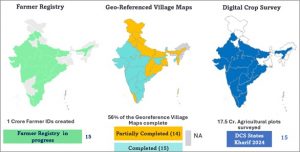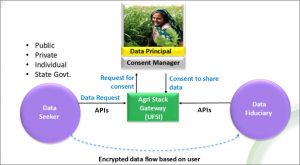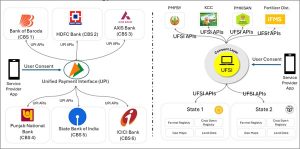India’s agriculture sector, a cornerstone of its economy has faced persistent challenges such as inefficiencies, insufficient credit, market access, and limited availability of quality inputs and resources. The introduction of Digital Public Infrastructure (DPI) for agriculture i.e. Agri Stack, under the Digital Agricultural Mission, marks a paradigm shift. Agri Stack througha comprehensive digital ecosystem approach offers scalable, interoperable, and inclusive solutions for farmers while fostering private innovation.
Agri Stack DPI is designed to enhance entire agricultural value chain by improving governance, service delivery, and inclusivity. By leveraging technology, it aims to build a transparent, efficient and sustainable digital agricultural ecosystem.

Figure 1: Illustration for principle of’ Farmer at the Centre’ of DPI approach for facilitating the delivery of digital solutions to farmers by Government, Agri Techs and other entities
Key Components of Agri Stack as DPI
Agri Stack is built on the core principles of interoperability, scalability, reusability, and private innovation across the agriculture sector-
- Digital Identity Systems: The core of Agri Stack includes the Farmer Registry, Geo Reference Village Maps, and Crop sown Registry. The digital identity i.e. Farmer ID (11 digitunique number) is a key to farmers’ demographic data, their land holdings and the seasonal crop data.

Figure 2: Farmers using Agri Stack DVC (Digitally verifiable credentials) as Kisan Pehchaan Patra
At present, digital identity is enabled for1 Crore farmers across the countrywith a plan to cover 6 crore farmers by end of March 2025.

Figure 3: Status of Agri Stack Core Registries across India
- Support Registries: A suite of 30+ Support Registries, including the Crop Registry, Seed Registry, Pesticide Registry, etc. are being put in place to standardize agricultural data nationwide. At present, 14 Support Registries are live to enable various use cases such as crop insurance, crop area estimation, crop procurement etc.
- Consent Manager: The Consent Manager ensures secure, consented data sharing while giving farmers granular control over sharing and revocation of consent, in line with the Digital Personal Data Protection Act, 2023.

Figure 4: Agri Stack in compliance with DPDP Act 2023
Unified Farmer Service Interface: UFSI acts as a gateway for seamless information exchange across heterogenous systems similar to how UPI facilitates transactions between banks where each CBS may have different architecture and systems as shown in the Figure below-

Figure 3: UFSI- UPI analogy for exchange of data through APIs
Built on a Federated Architecture, UFSI ensures secure and privacy compliant data sharing while empowering States and farmers to retain control over their data.
Agri Stack compliance to Principals of DPI

Figure 5: Agri Stack answers questions which many stakeholders want to know to provide their services such as Governments, private sector, academia etc.
Agri Stack’s design adheres to the principles of DPI
- Usability across Stakeholders: Components such as the Farmers Registry and Crop Sown Registry support multiple schemes, including credit, insurance, advisory services etc.
- Interoperability by Design: Standardized data and APIs specifications shall enable seamless data sharing across government, Agri-Techs and research organizations.
- Scalability for National Impact: Designed to support millions of farmers across diverse regions, Agri Stack is scalable and shall facilitate initiatives such as precision farming and improved market access.
- Inclusion at Its Core: Equitable access is ensured for smallholder farmers, agricultural labourers and women through features like consent and farmer centricity.
Beyond IT: Agri Stack as a Catalyst for Transformation
Agri Stack goes beyonda traditional IT project bycatalysingsystemic change in agriculture. Historically, the process of land record updation was fraught with challenges and was not an administrative urgency of the Revenue Department, resulting in outdated and inaccurate records that hindered economic development.
The formation of the Farmer Registry necessitates that all agricultural land parcels owned by farmers are updated and linked to their profile because benefits associated with farmland suchas crop insurance, seeds, fertilizers, and irrigation—will be tied to the Farmer Registry.Hence there is a direct and urgent demand for updating land records. This shall nudge both the farmers and the Revenue Department for land record management. Accurate and up-to-date land records shall reduce disputes, streamline service delivery, enhance supply chain efficiency, improve market access and contribute to GDP growth.
The Road Ahead
Agri Stack’s vision extends beyond land owning farmers to include animal husbandry, fisheries, tenant farmers, and forest land rights holders in the next phase of the Farmer Registry rollout. The Digital Crop Survey will be rolled out across the country from Kharif 2025.
Conclusion and Way Forward
The digital transformation of agriculture through Agri Stack harnesses emerging technologies to empower citizens, promote sustainability and create equitable access to opportunities. With its inclusive approach and emphasis on scalability, Agri Stack can revolutionize agriculture, enhance livelihood and drive national growth.
(Courtesy: PIB)








